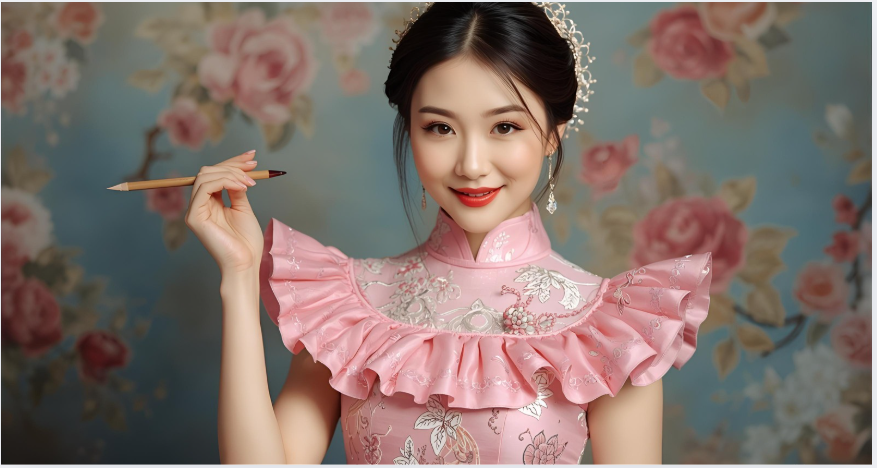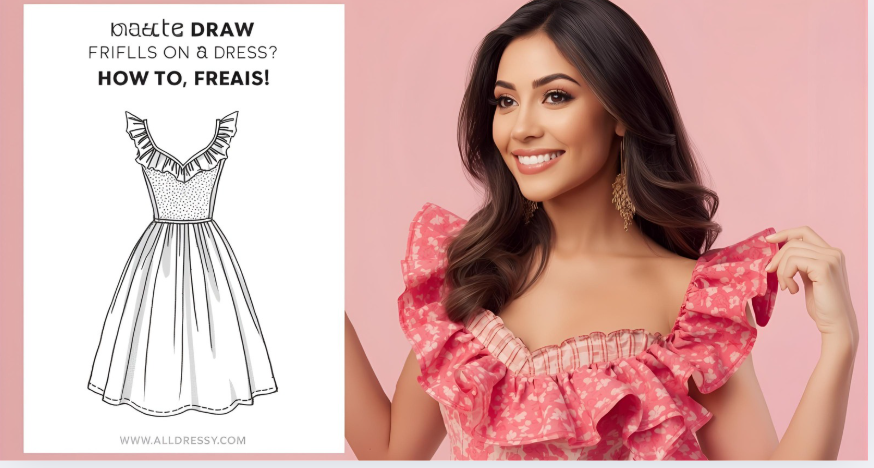Learning how to draw frills on a dress is one of the most delightful and rewarding skills for anyone interested in fashion illustration, digital art, or character design. Frills add softness, motion, and elegance to any outfit, transforming a simple dress into something visually captivating and full of personality.
Whether you’re creating a bridal gown, historical costume, or modern outfit sketch, mastering how to draw frills on a dress helps you understand fabric flow, volume, and the subtle play of light and shadow that gives life to your drawings.
In this detailed 2000-word guide, you’ll learn everything from the basic structure of frills to advanced rendering and shading. You’ll also find expert tips, common mistakes to avoid, and FAQs—all fully optimized to help your artwork stand out and your designs look stunning.
🌸 Introduction: Why Learning How to Draw Frills on a Dress Matters

Frills are delicate, decorative folds or pleats added to clothing for a soft, feminine, or romantic effect. When drawn properly, they enhance the realism of your artwork and bring out the beauty of fabric movement.
Understanding how to draw frills on a dress is not only about sketching curved lines—it’s about capturing texture, volume, and natural flow. Frills express the weight of the fabric, the direction of movement, and the mood of the wearer.
Frills are commonly used in:
- Bridal gowns and ball dresses
- Victorian and Rococo-inspired fashion
- Character art (especially in fantasy or anime)
- Historical illustrations
- Children’s dresses and costume design
By the end of this guide, you’ll know how to draw frills on a dress so realistically that they almost look like they could flutter in the wind.
✏️ Understanding the Basics of Frills

Before learning how to draw frills on a dress, it’s essential to understand their anatomy.
What Are Frills?
Frills (also known as ruffles) are strips of fabric gathered, pleated, or folded to create a decorative edge. When viewed closely, each frill consists of:
- Top gathering line: Where the fabric bunches up.
- Wavy fold: The visible curved edge of the fabric.
- Depth and shadows: Created by light falling on overlapping folds.
Each frill behaves differently depending on the fabric type (cotton, silk, chiffon, tulle) and tightness of the gathering.
🧵 Materials You’ll Need
Before you start drawing, gather these essential tools:
- Drawing paper or sketchbook
- Pencils (HB, 2B, and 4B)
- Fine liner or inking pen
- Eraser and sharpener
- Blending stump or tissue
- Optional: Colored pencils, watercolor, or digital tablet
For digital artists, programs like Procreate, Photoshop, or Clip Studio Paint offer brushes that mimic fabric texture—perfect for drawing frills.
🧍♀️ Step-by-Step Guide: How to Draw Frills on a Dress
Follow these simple but powerful steps to draw realistic and flowing frills on your dress design.
Step 1: Draw the Body Base and Dress Silhouette
Start with the foundation before adding any frills.
- Sketch a light human figure outline—head, torso, hips, and legs.
- Draw a vertical balance line through the center for symmetry.
- Outline the dress shape — A-line, ball gown, pencil, or mermaid style.
- Keep the posture natural; a slightly tilted or curved stance adds realism.
🩰 Pro Tip: The way the body bends will affect how frills drape and move.
Step 2: Decide Where the Frills Will Go
Frills can appear in many parts of the dress:
- Along the neckline or sleeves
- At the waist or hemline
- As layered tiers on the skirt
- Around the collar or cuffs
Lightly mark the positions where frills will be added. Placement is key to maintaining visual balance.
Step 3: Draw the Base Line for Each Frill
For each frill section:
- Draw a wavy line where the fabric gathers.
- Keep the waves soft and irregular — avoid mechanical curves.
- The tighter the wave, the more ruffled the frill will appear.
This wavy base line represents the top edge of the frill where fabric is stitched or gathered.
Step 4: Create the Lower Edge of the Frill
Next, draw the bottom edge of the frill.
- Draw another wavy line below the first, following the same rhythm.
- Keep the gap between lines consistent to show the fabric’s thickness.
- The lines should connect at the curves, forming loops and folds.
The result should resemble a soft wave pattern—like rolling hills.
Step 5: Add Folds and Depth
This is the key to realism. Each frill fold should look like it’s overlapping the one behind it.
- From the top line, draw short curved lines downward to indicate fabric folds.
- These lines should vary slightly in length and direction.
- Add inner curves to show where light doesn’t reach.
💡 Tip: Visualize how light hits the fabric — the undersides of folds are darker, while upper curves are lighter.
Step 6: Draw Multiple Frill Layers
If your dress has more than one frill layer (like a tiered gown or flamenco dress):
- Repeat the wavy pattern below the first frill layer.
- Overlap slightly to show layering.
- Make lower frills longer and looser for a cascading effect.
The more layers you add, the more luxurious and voluminous your dress looks.
Step 7: Add Fabric Flow and Movement
To make your frills appear lively:
- Curve the frills slightly in the direction of motion (e.g., wind or walking).
- Add diagonal flow lines on skirts to suggest motion.
- If the dress twirls, frills should fan outward naturally.
This step gives your frill design energy and realism.
Step 8: Clean the Lines
Use a fine liner or darker pencil to go over the final outlines. Erase any sketchy or overlapping lines.
At this stage, your frills should have a clean, defined, and dynamic look.
Step 9: Add Shading and Highlights
This step transforms flat frills into 3D folds.
- Determine the light source (top, left, or right).
- Shade underneath the overlapping folds.
- Keep the upper parts of curves lighter.
- Use blending tools to create smooth gradients.
🪞 Expert Tip: For sheer or thin fabrics, use softer, lighter shading and leave more white space.
Step 10: Add Final Details and Embellishments
Now bring your dress to life with artistic details:
- Lace edges
- Beads or embroidery
- Ribbon trims
- Small bows at the frill joints
Each detail enhances the charm and personality of your drawing.
🌺 Advanced Techniques for Drawing Realistic Frills
To make your artwork stand out from competitors, apply these professional-level methods.
1. Vary Your Line Weight
Use thick and thin lines to add texture:
- Thick lines for shaded edges.
- Thin lines for light, airy fabrics.
This adds a professional dynamic look to your frills.
2. Observe Real Fabric
Study real-life dresses, curtains, or clothing folds. Notice how:
- Frills compress tightly near seams.
- Light scatters softly across curved fabric.
- Frills at the bottom are more relaxed than at the top.
Real observation helps you draw with believable accuracy.
3. Experiment with Fabric Types
Different fabrics create different frill effects:
- Chiffon or tulle: Soft, floating lines with light shading.
- Satin or silk: Smooth waves with strong highlights.
- Cotton: Sharper folds with visible creases.
Practice with each texture to expand your drawing versatility.
4. Add Shadow Layers
For professional realism:
- Add cast shadows where frills overlap each other.
- Use multiple tones (light, medium, dark).
- Blend smoothly for natural results.
This method gives your drawing a more three-dimensional and polished appearance.
5. Digital Techniques
If you’re drawing digitally:
- Use a soft round brush for base color.
- Apply Multiply layer mode for shadows.
- Use Overlay or Screen layers for highlights.
- Add slight blur for silk or sheer effects.
These layers make digital frills appear rich and realistic.
🧠 Common Mistakes to Avoid When Drawing Frills
Avoiding these errors can instantly improve your work:
- ❌ Even, repetitive curves: Real frills have natural variations.
- ❌ Ignoring fabric weight: Heavy fabrics don’t float; they droop naturally.
- ❌ Flat shading: Without shadows, frills look lifeless.
- ❌ Overcrowding: Too many frills can overwhelm your design.
- ❌ Unclear light source: Always know where your light comes from.
Fixing these issues will make your frills look elegant, realistic, and professional.
🎨 Coloring Frills on a Dress
Adding color enhances dimension and visual impact.
Step-by-Step Coloring Process:
- Base Layer: Lightly color the entire frill area.
- Shadow Layer: Darken the undersides of folds.
- Highlight Layer: Use white or lighter tones for raised areas.
- Blend Gradients: Smooth transitions create realistic depth.
🖌️ Color Ideas:
- Soft pink or lavender for romantic dresses.
- Gold or red for evening wear.
- White or cream for bridal or fantasy designs.
Contrast between shadow and highlight defines frill structure beautifully.
🌼 Practice Exercises for Mastering Frill Drawing
To improve your skill in how to draw frills on a dress, try these:
- Draw individual frills from different angles.
- Sketch frills on mannequins or from photos.
- Practice combining frills with lace, bows, or ribbons.
- Time yourself—draw 5-minute frill studies to improve speed.
Consistent daily practice will refine your accuracy and confidence.
💬 FAQs About How to Draw Frills on a Dress
Q1: How do I start drawing frills as a beginner?
Start by practicing single wavy lines and then pair them to form folded layers. Once you’re comfortable, place them on dress outlines.
Q2: What’s the difference between frills and ruffles?
They’re very similar—frills are often lighter and narrower, while ruffles are broader, with deeper folds. Both follow the same drawing principles.
Q3: How can I make frills look 3D?
Use a clear light source and strong contrast between shaded areas and highlights. The underside of each fold should be the darkest part.
Q4: Should I use reference photos?
Absolutely. Studying real fabric helps you understand how frills naturally drape and fold.
Q5: Can I draw frills digitally?
Yes! Digital tools let you use multiple layers, blend modes, and textured brushes to achieve realistic effects.
Q6: What pencil grade is best for drawing frills?
Use HB for outlines, 2B for mid-shading, and 4B or 6B for deeper folds.
Q7: How do I draw frills in motion?
Tilt the waves and folds in the direction of movement. Add stretched folds to indicate fabric tension.
Q8: How do I keep frills proportional on the dress?
Measure equal spacing between frills, and follow the body’s contour lines to maintain natural flow.
Q9: How do I draw transparent or sheer frills?
Use faint lines and light shading. Avoid heavy outlines and leave partial transparency between overlapping layers.
Q10: How can I improve faster?
Draw from real references daily, focus on light and shadow practice, and review your drawings to spot improvement areas.
🌷 Conclusion: Mastering How to Draw Frills on a Dress
Learning how to draw frills on a dress is more than just adding decoration—it’s about understanding how fabric behaves, flows, and interacts with light. With patience and consistent practice, you can make any dress sketch look elegant, soft, and full of motion.
Here’s a recap of what you’ve learned:
- Start with a solid dress silhouette.
- Place frills logically and naturally.
- Build depth with overlapping waves.
- Use shading and highlights to show volume.
- Study real fabric for authentic results.
Whether you’re designing for fashion, illustrating characters, or creating digital artwork, frills bring beauty and sophistication to your designs. Keep experimenting with styles, fabrics, and movements until your frills look as soft and lively as real fabric.
Your journey to mastering how to draw frills on a dress starts today—with every line, curve, and fold, you’ll bring more grace and realism to your art than ever before
